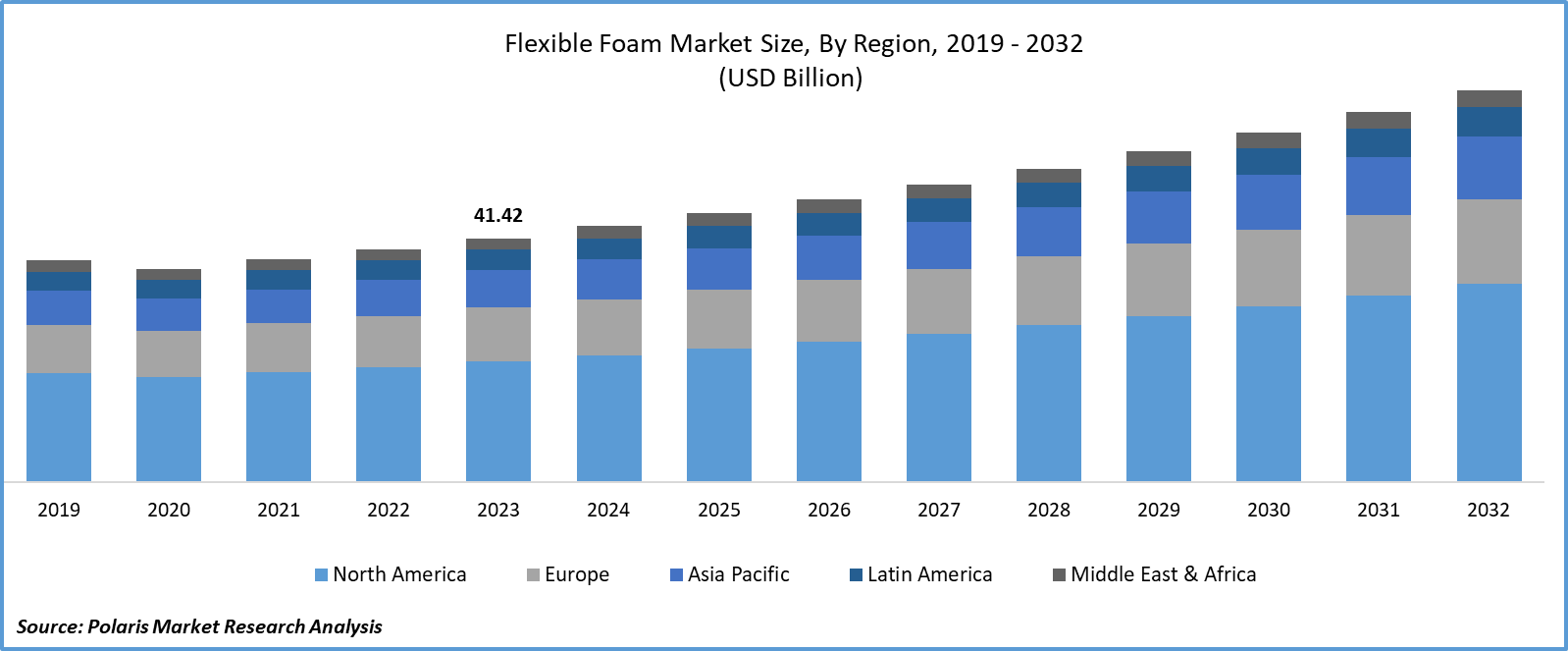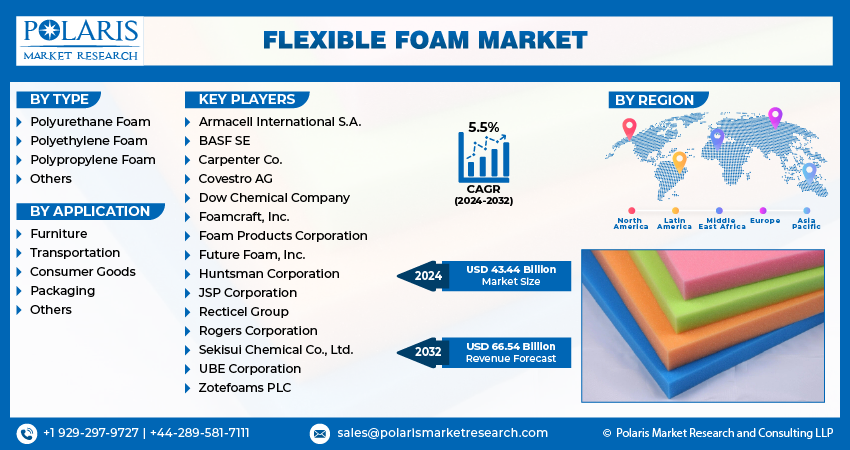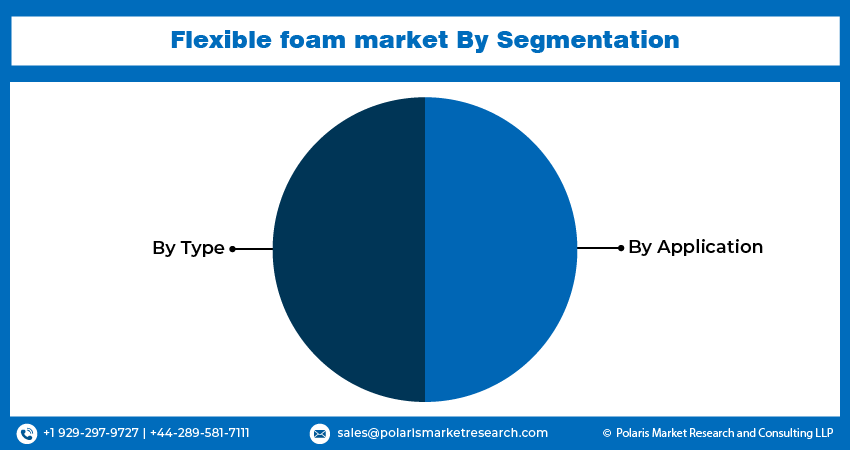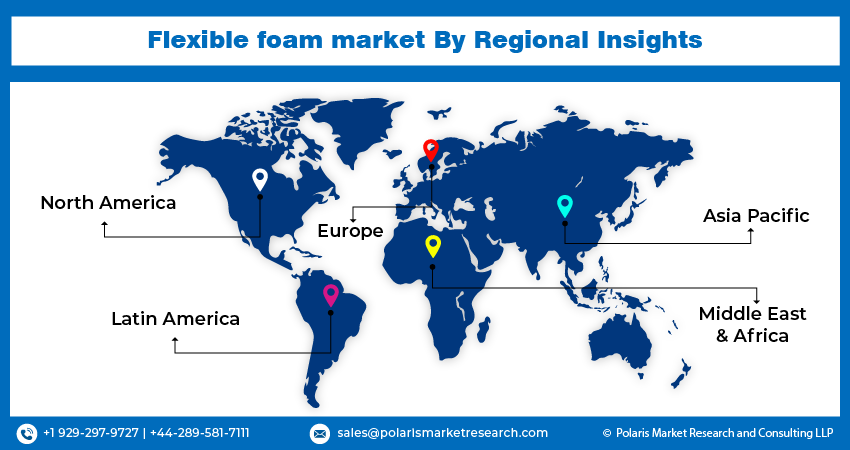
Flexible Foam Market Share, Size, Trends, Industry Analysis Report, By Type (Polyurethane Foam, Polyethylene Foam, Polypropylene Foam, Others); By Application; By Region; Segment Forecast, 2024- 2032
- Published Date:Apr-2024
- Pages: 117
- Format: PDF
- Report ID: PM4845
- Base Year: 2023
- Historical Data: 2019-2022
Report Outlook
Flexible Foam Market size was valued at USD 41.42 billion in 2023. The market is anticipated to grow from USD 43.44 billion in 2024 to USD 66.54 billion by 2032, exhibiting the CAGR of 5.5% during the forecast period.
Market Introduction
The rise in furniture production fuels the flexible foam market. With growing consumer demand for furniture worldwide, manufacturers increasingly turn to flexible foam materials for various applications. Polyurethane foam and memory foam, renowned for resilience and comfort, are extensively used in furniture manufacturing for cushioning and padding. Versatility and adaptability make flexible foam ideal for meeting evolving consumer preferences in furniture design. Additionally, a focus on sustainability drives the adoption of eco-friendly foam materials.
In addition, companies operating in the market are introducing new products to expand market reach and strengthen presence.

To Understand More About this Research: Request a Free Sample Report
For instance, in February 2024, the Vita Group introduced its eco-friendly PU foam line named Orbis. Orbis presents a new range of sustainable PU foams crafted from polyols derived from recycled post-consumer foam mattresses.
Innovation in material technology propels the flexible foam market, driving advancements in formulations and manufacturing processes. These innovations yield flexible foams with enhanced properties like durability, sustainability, and comfort, meeting stringent regulatory standards. Technological breakthroughs such as additive manufacturing and nano-engineering revolutionize foam production, allowing for intricate designs and precise control over material properties. These developments cater to diverse industries, including automotive, furniture, bedding, packaging, and construction. Additionally, the emphasis on eco-friendly materials and circular economy principles fuels the development of bio-based and recyclable foams, meeting the rising demand for sustainable solutions. With ongoing advancements, the flexible foam market is poised for further expansion, offering innovative solutions to meet evolving industry needs.
Industry Growth Drivers
Increasing Demand from Automotive Sector is Projected to Spur the Product Demand
The flexible foam market experiences a surge in demand propelled by the automotive sector. Automotive manufacturers prioritize lightweighting and fuel efficiency, favoring flexible foam materials for seating, interior trim, and insulation components. These foams offer superior cushioning, sound absorption, and vibration damping properties. The rise of electric vehicles (EVs) and autonomous driving technologies further boosts demand for lightweight and noise-reducing materials in vehicle interiors. Stringent regulatory standards for vehicle safety and comfort also drive adoption. Industry players invest in R&D to innovate new foam formulations and processes, seizing opportunities in this market.
Growth in Construction Industry is Expected to Drive Flexible Foam Market Growth
The construction industry's growth significantly propels the flexible foam market expansion. Urbanization and infrastructure development projects globally fuel demand for flexible foam materials in construction. Polyurethane and polyethylene foams, favored for insulation, cushioning, and sealing in buildings, offer exceptional thermal insulation and versatility. Additionally, the trend toward sustainable, energy-efficient buildings boosts flexible foam adoption, enhancing structures' energy efficiency and environmental performance. As construction escalates, especially in emerging economies, the demand for flexible foam products surges, driving market growth.

Industry Challenges
Volatility in Raw Material Prices is Likely to Impede the Market Growth
Volatility in raw material prices impacts the flexible foam market. Fluctuations in prices of key inputs like polyols and diisocyanates directly affect production costs for foam manufacturers. Factors such as changes in crude oil prices and geopolitical tensions contribute to this unpredictability. Managing these fluctuations poses challenges for manufacturers, who must adjust pricing strategies and optimize supply chains to maintain profitability. Additionally, uncertainty in raw material prices may influence end-user purchasing decisions. Effective supply chain management and strategic planning are crucial for navigating market fluctuations and ensuring competitiveness in the flexible foam market.
Report Segmentation
The flexible foam market analysis is primarily segmented based on type, application, and region.
|
By Type |
By Application |
By Region |
|
|
|
To Understand the Scope of this Report: Speak to Analyst
By Type Analysis
Polyurethane Foam Segment Held Significant Revenue Share in 2023
The polyurethane foam segment held significant revenue share in 2023. Its versatility allows for customization in density, firmness, and resilience, catering to diverse application needs across industries. Polyurethane foam finds widespread use in furniture, automotive, construction, and packaging, due to its superior properties, including excellent cushioning, thermal insulation, and acoustic performance. Additionally, its lightweight nature, durability, and ability to conform to different shapes contribute to its popularity. Furthermore, polyurethane foam's cost-effectiveness compared to alternative materials makes it an attractive choice for manufacturers seeking high-performance solutions at competitive prices. Continuous research and development efforts drive innovations in foam formulations, further expanding its applications and solidifying its position as a preferred material in the flexible foam market.
By Application Analysis
Furniture Segment Held Significant Revenue Share in 2023
The furniture segment held significant revenue share in 2023. Flexible foam materials excel in providing both comfort and durability, making them highly sought-after for furniture upholstery, mattresses, and cushions. Moreover, these materials offer versatility, allowing for easy customization to meet specific comfort and design requirements, thereby satisfying diverse consumer preferences. Additionally, advancements in foam manufacturing technology have facilitated innovative furniture designs, incorporating features such as ergonomic support and pressure relief. Foam materials find extensive applications across various furniture types, further bolstering their revenue contribution. With increasing consumer awareness of the importance of comfort and ergonomic support in furniture, demand for flexible foam-based products continues to grow.

Regional Insights
Asia-Pacific Region Accounted for a Significant Market Share in 2023
In 2023, Asia-Pacific region accounted for a significant market share. Rapid industrialization and urbanization drive demand across construction, automotive, furniture, and packaging industries. Booming construction activities and infrastructure development contribute to robust demand for flexible foam insulation and sealing materials. Additionally, the region's expanding automotive sector fuels demand for foam materials in vehicle interiors and noise reduction applications. Rising consumer spending and urban lifestyles lead to increased demand for furniture and bedding, further driving flexible foam adoption. Moreover, Asia-Pacific's status as a manufacturing hub attracts investments, supporting the demand for foam materials in various production processes.
The market in North America is influenced by the region's strong industrial base, particularly in automotive, furniture, and construction sectors, driving demand for flexible foam materials. Steady growth in the construction industry, coupled with stringent regulations on energy efficiency and safety, further boosts demand for foam insulation. Technological advancements and innovation contribute to the development of advanced foam formulations, meeting diverse market needs. Changing consumer preferences towards comfort and sustainability also play a significant role in driving demand for flexible foam materials in furniture and bedding. Additionally, the presence of key players in the region ensures a wide range of products to cater to market demands effectively.

Key Market Players & Competitive Insights
The flexible foam market involves a diverse array of players, and the expected arrival of new contenders is poised to intensify rivalry. Established leaders continuously enhance their technologies to maintain a competitive advantage, emphasizing effectiveness, reliability, and safety. These firms prioritize strategic actions such as establishing collaborations, improving product portfolios, and participating in cooperative endeavors. Their aim is to outperform competitors within the field, securing a significant flexible foam market share.
Some of the major players operating in the global flexible foam market include:
- Armacell International S.A.
- BASF SE
- Carpenter Co.
- Covestro AG
- Dow Chemical Company
- Foamcraft, Inc.
- Foam Products Corporation
- Future Foam, Inc.
- Huntsman Corporation
- JSP Corporation
- Recticel Group
- Rogers Corporation
- Sekisui Chemical Co., Ltd.
- UBE Corporation
- Zotefoams PLC
Recent Developments
- In September 2023, Covestro and the Polish construction chemicals producer, Selena Group, joined forces to develop a greener selection of polyurethane (PU) foams aimed at improving thermal insulation in buildings.
- In December 2021, Stora Enso expanded its packaging solutions by introducing a new lineup of bio-derived foams sourced from wood. These items are entirely recyclable and suitable for both protective and thermal packaging purposes.
- In October 2022, BASF initiated the construction of its latest Polyurethane Application Development Laboratory in Mumbai, India. This facility aims to enhance partnerships with Indian clients across burgeoning sectors such as construction, consumer appliances, furniture, footwear, and transportation.
Report Coverage
The flexible foam market report emphasizes on key regions across the globe to provide better understanding of the product to the users. Also, the report provides market insights into recent developments, trends and analyzes the technologies that are gaining traction around the globe. Furthermore, the report covers in-depth qualitative analysis pertaining to various paradigm shifts associated with the transformation of these solutions. The report provides detailed analysis of the market while focusing on various key aspects such as competitive analysis, types, applications, and their futuristic growth opportunities.
Flexible Foam Market Report Scope
|
Report Attributes |
Details |
|
Market size value in 2024 |
USD 43.44 billion |
|
Revenue forecast in 2032 |
USD 66.54 billion |
|
CAGR |
5.5% from 2024 – 2032 |
|
Base year |
2023 |
|
Historical data |
2019 – 2022 |
|
Forecast period |
2024 – 2032 |
|
Quantitative units |
Revenue in USD billion and CAGR from 2024 to 2032 |
|
Segments covered |
|
|
Regional scope |
|
|
Competitive Landscape |
|
|
Report Format |
|
|
Customization |
Report customization as per your requirements with respect to countries, region, and segmentation. |
FAQ's
The global Flexible Foam market size is expected to reach USD 66.54 billion by 2032
Key players in the market are Armacell International S.A., BASF SE, Covestro AG, Dow Chemical Company, Huntsman Corporation
Asia-Pacific contribute notably towards the global Flexible Foam Market
Flexible Foam Market exhibiting the CAGR of 5.5% during the forecast period.
The Flexible Foam Market report covering key segments are type, application, and region.
